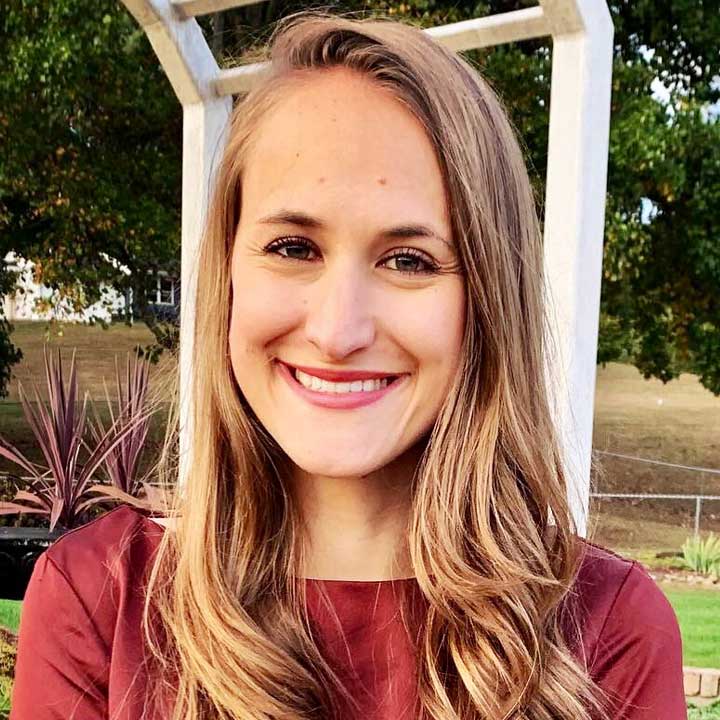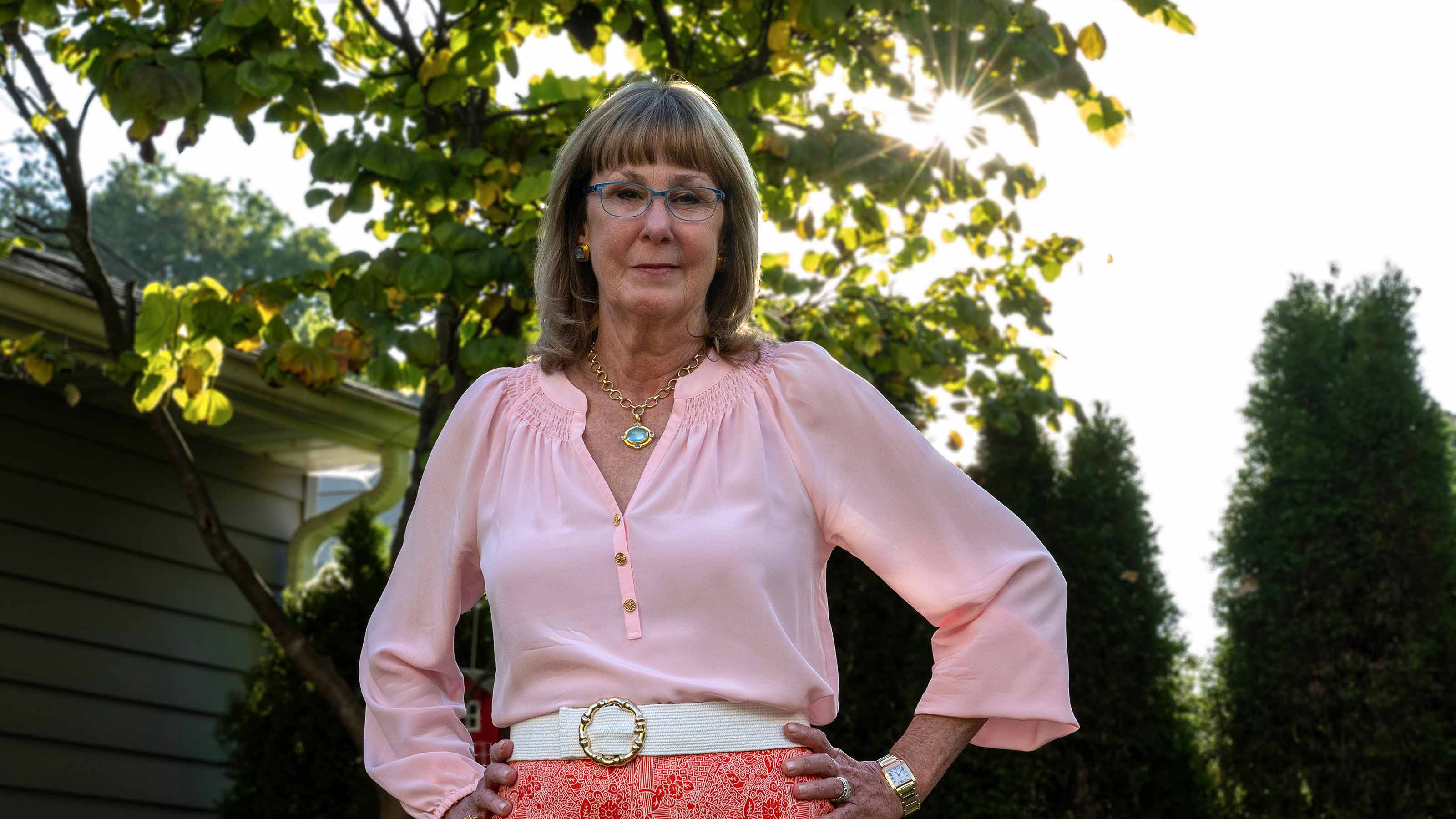Heart researcher takes on unlikely disease: cancer
Dr. Sakima Smith’s groundbreaking research is expanding understanding of the connection between cancer treatment and heart disease in the pioneering field of cardio-oncology.
Sakima Smith, MD, MPH, was a first-year attending physician when he encountered a 28-year-old patient in cardiac shock.
The patient, named Tyler, was a healthy young man with no apparent risk factors for heart problems. But a review of his medical records revealed that at the age of 3, he had undergone chemotherapy for lymphoma. It didn’t take long for Dr. Smith to connect the dots between the two events.
While Tyler received a heart transplant and made a full recovery, his case lit a fire in Dr. Smith to understand why cardiologists were seeing so many cancer patients with heart problems years or decades after successful treatment.
An accomplished heart failure and transplant cardiologist and researcher, Dr. Smith turned to his laboratory to look for answers. Now, nearly a decade later, Dr. Smith has emerged as a pioneer in the growing field of cardio-oncology. Simply by following the questions that fascinate him most, he is gradually unraveling the mystery of why some cancer patients are susceptible to heart problems and how those problems can be avoided.
Laying the groundwork for a career in medical research
Raised in St. Louis, Dr. Smith discovered a passion for science and medicine at an early age. His father, who had studied biology, always encouraged him to follow his natural curiosity. He earned a bachelor’s degree at Truman State University and an MD at Temple University with a plan in the back of his mind to pursue cardiology. “My grandfather died of a massive heart attack when I was only 8, and I remember being struck by the thought that this one organ was so important,” he says. “That stayed with me.”
His internal pull toward cardiology grew stronger at Temple, home to one of the largest heart transplant centers on the East Coast. It only took one rotation to persuade him to forge a career path in heart failure transplant cardiology. When he returned home for a three-year residency at Washington University in St. Louis, most friends and colleagues expected him to plant permanent roots.
“But I was at a stage when I didn’t have the mentorship I was seeking, so I was open-minded about where to go for the critically important next stage of my training,” Dr. Smith remembers. He interviewed at The Ohio State University Wexner Medical Center in 2009 and “fell in love with the possibilities for growth” he witnessed at the Ohio State Richard M. Ross Heart Hospital. “I was blown away at the transparency and connectedness I observed,” he says.
“I knew this was the right place to complete my research and transplant fellowships. What I didn’t know was that 13 years later, I would still be here!”
Today, Dr. Smith holds the Bob Frick Research Chair in Heart Failure and Arrhythmia at the Frick Center for Heart Failure and Arrhythmia and works as an associate professor of Internal Medicine in the Ohio State College of Medicine.

Back to basics
After three years of cardiology fellowship training, Dr. Smith joined the lab of Peter Mohler, PhD, the chief scientific officer of the Ohio State Wexner Medical Center, in 2012. A six-month research rotation turned into two years that would forever alter the trajectory of his career.
Until that point, Dr. Smith had enjoyed trying his hand at clinical research, which tests new methods of diagnosis, prevention and treatment on human subjects. He never felt particularly drawn to basic science research, which examines the DNA, cells, proteins, molecules and other basic building blocks of life to understand how they function. He was interested in pursuing translational research, which bridges clinical and basic research by testing new treatments and therapies at the bedside, but Dr. Mohler’s lab was primarily focused on discovering the mechanisms underlying abnormal heart rhythms and heart failure.
“I told Dr. Mohler I wasn’t all that interested in basic research, but I would try it for a while,” Dr. Smith recalls. To his surprise, the first research projects he joined were immediately applicable to what he was learning as a trainee in heart failure and transplant, from implanting telemeters that monitor a patient’s vitals remotely to interpreting an echocardiogram. “I realized quickly that I had questions on the clinical side that could only be solved by basic science,” he says.
During his time in the Mohler Lab, the primary question he used basic science methods to explore was the role of a specific protein, beta2-spectrin, in heart failure and heart rhythm disorders. “It was clear that a breakdown of this protein was tied to heart problems, but we didn’t understand what was happening or how this information could be useful,” Dr. Smith says.
Ohio State’s Center for Clinical and Translational Science awarded Dr. Smith and a group of colleagues a yearlong grant to explore these questions. In this period, the team identified a new class of gene mutations that changed how beta2-spectrin interacted with another protein, ankyrin-B, that forms the scaffolding of the heart cell membrane. When this scaffolding collapses, it damages cardiac electrical circuits and leads to abnormal heart rhythms.
Dr. Smith was absent from a clinical setting for an entire year as he worked on this project and obtained a master’s degree in Public Health and Clinical Research, but his year away was one of the most formative of his career.
“It was a humbling experience to immerse myself in basic research,” he remembers. “I had to kick my ego to the curb. But under the mentorship of Dr. Mohler, who is now a friend, I realized how much I enjoy basic and translational research.”
In Dr. Mohler’s experience, not every physician will fall in love with research. “But, for those that enjoy the puzzles of the lab, something often clicks and they are off to the races,” he explains. “What I saw in Sakima was a stubborn desire to master new techniques and areas of discovery. Through every challenge, he stayed enthusiastic and curious, and he kept showing up. Those are the qualities of someone with research potential.”
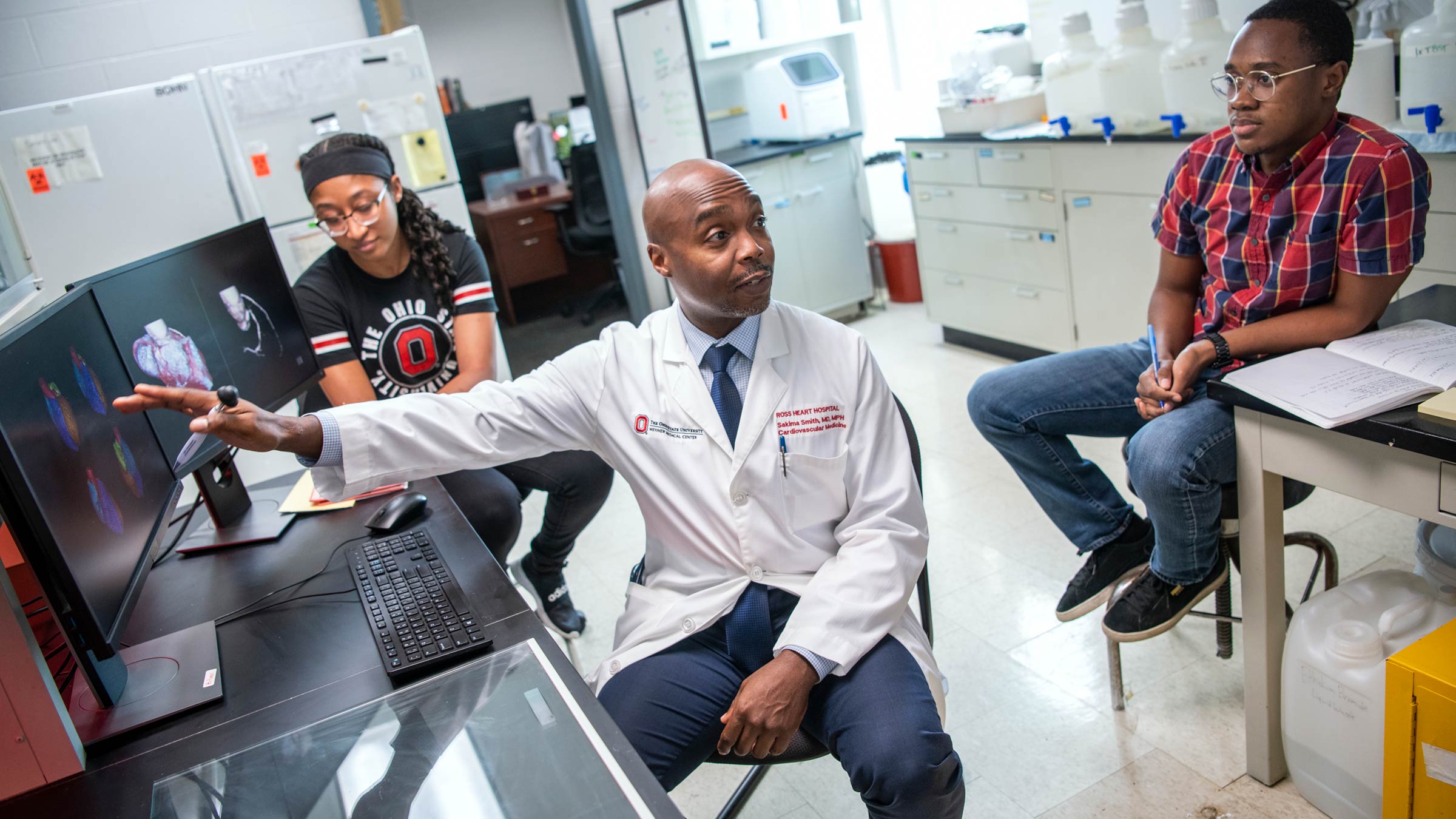
Making progress in heart research and cardio-oncology
Brimming with ideas for future research, Dr. Smith joined the faculty at the Ohio State Wexner Medical Center in 2014 and started his own laboratory a year later.
For the past eight years, he has built upon the beta2-spectrin research he initiated in the Mohler Lab, often in collaboration with Dr. Mohler. Ultimately, their aim is to build an early diagnostic platform that uses blood tests to identify beta2-spectrin in the blood. “Spectrin breakdown will show up on a blood test, which could help us know if there is heart damage,” Dr. Smith says.
“Sakima was one of the first to understand that losing a protein like beta2-spectrin is a canary in a coal mine,” Dr. Mohler says. “Developing a diagnostic tool that helps us predict the first stages of cardiovascular disease is an enormous breakthrough for the field.”
The second major research area in the Smith Lab, cardio-oncology, began as a side project around 2016, when Dr. Smith connected with a friend who practices oncology at the Mayo Clinic. They struck up a series of conversations about the impact of anti-cancer drugs on the heart and a collaboration was born.
“The field was intriguing and new, and there was so much we didn’t understand,” Dr. Smith says.
Meeting Tyler, the 28-year-old in heart failure, not long after these conversations, strengthened his resolve to dig deeper.
Dr. Smith made his first foray into cardio-oncology by looking more closely at tyrosine kinase inhibitors (TKIs) and anthracyclines, two well-established classes of cancer drugs. He relied on his friend at Mayo Clinic to decide which TKIs to target first, while his friend relied on him to put together a cardiovascular phenotype, which involves determining the composition and function of a heart to help calculate risk.
From there, Dr. Smith tested a first-generation drug, attempting to mimic a human chemotherapy cycle. Once he identified a test subject’s cardiovascular phenotype by taking blood pressure, looking at an electrocardiogram and looking at proteins on a molecular level, he could start making connections.
Over time, studying TKIs has produced sobering data: At least two-thirds of patients who receive TKI treatment experience negative cardiovascular side effects like blood clots, high blood pressure and irregular heart rhythm.
The outlook is similar for anthracyclines, which were linked to heightened patient risk for heart problems for decades before anyone understood the reason. Several years ago, Dr. Smith joined a team of researchers who examined an anthracycline called doxorubicin. By examining this drug through a basic science lens, the team discovered that it latches onto a specific type of transporter protein that carries it from the blood to the heart cells. Introducing another anti-cancer drug called nilotinib in advance of the doxorubicin interrupts this delivery, protecting the patient’s heart from damage. The team is in the process of designing human trials of the drug intervention in hopes of catalyzing wider impact.
While TKIs and anthracyclines will remain in use for the time being, especially when used in combination with other therapies, Dr. Smith expects checkpoint inhibitors and immunotherapies to rise in popularity. “With these newer classes of drugs, we don’t understand cardiovascular side effects quite as well,” he says. Researchers do know that these side effects may not be as common as with older drugs, but they are often more severe. Myocarditis, a heart condition in which the wall of the heart becomes inflamed, linked to newer drugs, may only occur in 1-2% of patients, for example, but the mortality rate can be close to 50%. “There is still so much to investigate,” Dr. Smith acknowledges.
Dr. Smith remains humble, ever cognizant of how much ground is left to cover, but his colleagues speak admiringly of what he has achieved.
“Before Sakima came on the scene, there was agreement that some patients experienced systemic toxicity issues with some cancer drugs,” says Thomas Hund, PhD, the director of the Dorothy M. Davis Heart Lung Research Institute whose lab is located next to Dr. Smith’s lab at the Frick Center for Heart Failure and Arrhythmia. “He has made a tremendous impact on the field of cardio-oncology by mapping out novel hypotheses about how cancer drugs are directly impacting cardiac cells. He is really shifting the paradigm. To my knowledge, there are no other investigators with the background to do what he’s doing so effectively.”
Dr. Smith’s success comes as no surprise to Dr. Mohler, who witnessed the makings of a high-impact researcher in his own lab. “A lot of Sakima’s strengths — curiosity, open-mindedness, team mentality — have combined to allow him to see emerging areas of medicine,” Dr. Mohler says. “By collaborating well with oncologists and pushing them to develop therapeutics outside their own clinical area, he seized an opportunity that most cardiologists had not yet identified.”
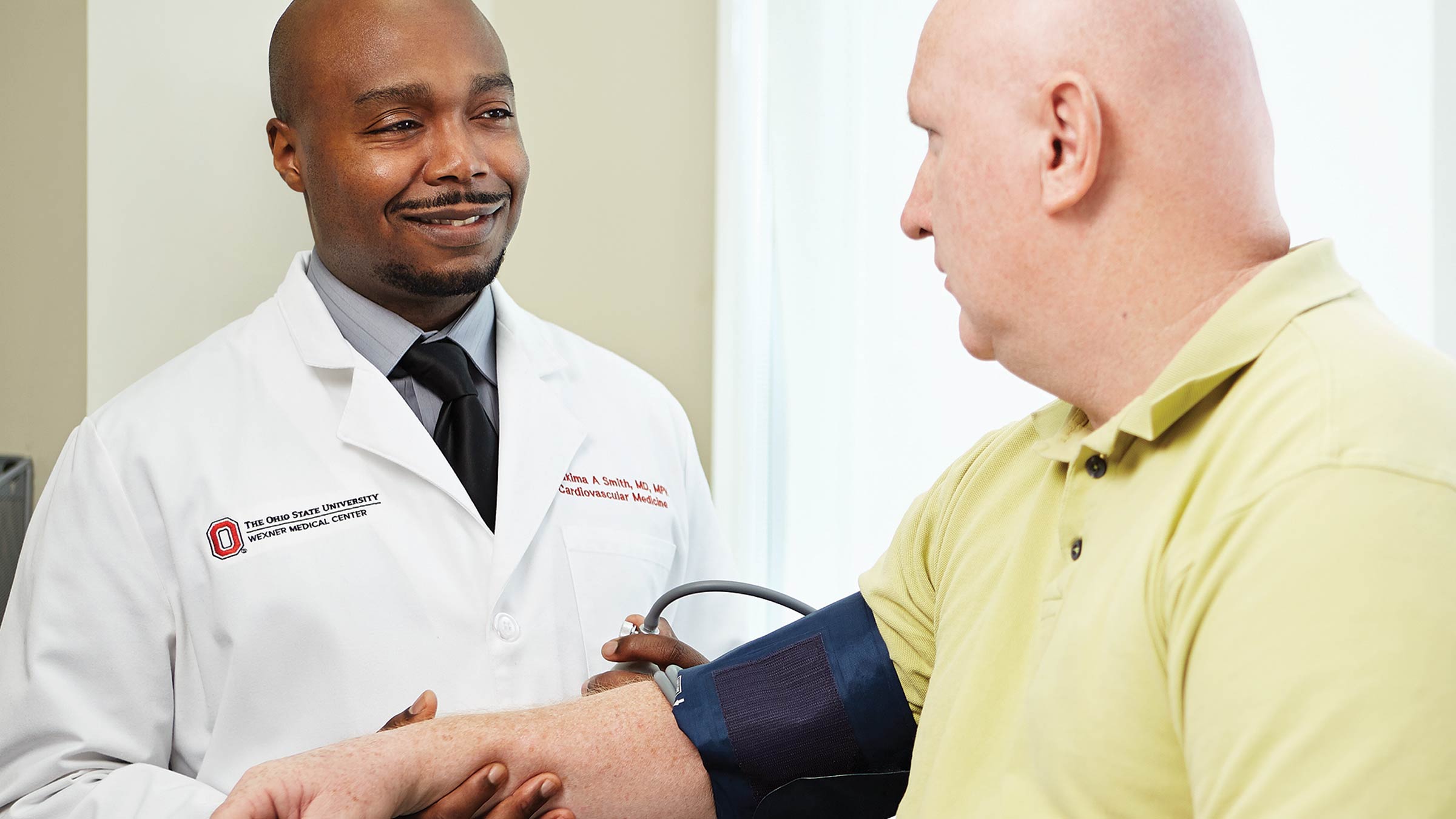
The next frontiers in cardio-oncology
Led by Daniel Addison, MD, and Ragavendra Baliga, MBBS, Ohio State’s cardio-oncology group is one of only a handful of its kind in the United States. The close collaboration between heart specialists and oncologists at The Ohio State University Comprehensive Cancer Center – Arthur G. James Cancer Hospital and Richard J. Solove Research Institute (OSUCCC – James) provides a unique opportunity to leverage the expansive research capabilities of a National Cancer Institute-designated Comprehensive Cancer Center to further this work. The group consists of more than a dozen cardiologists and oncologists, with active collaboration with emergency medicine, biomedical engineering and other disciplines. Over the next five years, the group aims to establish a robust clinical partnership between the Ohio State Ross Heart Hospital and The James.
“In terms of research, our team can compete with anyone in the country, but what will propel Ohio State to the top of the field is having established service lines and consult services between the Ross Heart Hospital and The James,” Dr. Smith says.
Ideally, the cardio-oncology program will eventually offer consultative services, clinics, research programs and training programs under one umbrella. A cancer patient will go to an oncology appointment at The James and, during the same visit, see a cardiologist who performs cardiac imaging to help determine their level of risk for heart problems following cancer treatment. If warranted, a patient would begin taking a cardio-protective drug to prevent heart damage from occurring. In future appointments, oncologists will screen the blood for early warning signs of heart damage before symptoms become irreversible.
This vision hinges on the ability of researchers like Dr. Smith to identify biomarkers in the blood to detect heart damage, as well as identify drugs that can protect the heart before damage even occurs. Currently, the members of his lab are hard at work identifying which drugs that are currently on the market may offer protection to the heart. “We’re starting to see promise with certain classes of medications, like statins,” he says, “but we’re still in early stages of research.”
Determining who needs to take a cardio-protective drug before cancer treatment is the million-dollar question, Dr. Smith says. If researchers can identify the 5-10% of patients who are at the highest risk of heart problems, they can target that population without exposing every cancer patient to the side effects of a cardio-protective drug they may not need.
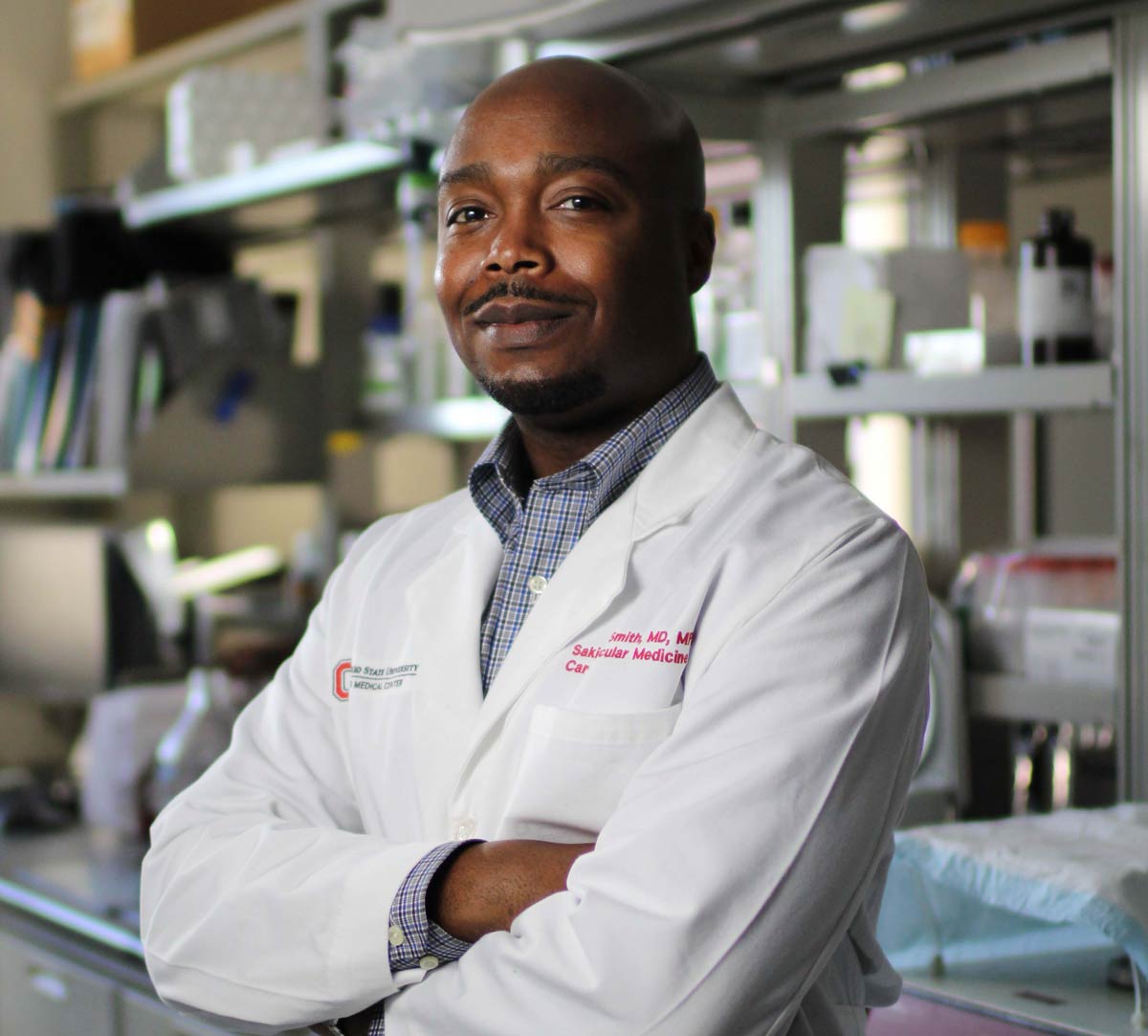
“This is personalized medicine at its finest,” Dr. Smith says. “Our risk assessment will be based on genetics, lifestyle, comorbidities — everything you can think of.”
With an aging population at greater risk for cancer and heart disease, the stakes have never been higher.
“The pressure is on to accelerate the speed of discovery and translate bench research into bedside care,” Dr. Smith says. “Fortunately, Ohio State is well-positioned to lead in the emerging field of cardio-oncology. We are ready for the challenge.”
Editor’s note: Ohio State’s Center for Clinical and Translational Science (CCTS) is now known as the Clinical and Translational Science Institute (CTSI) as of August 2024.

Your heart is in the right place
Learn more about advances in care and treatment for patients at The Ohio State University Heart and Vascular Center
Expert care starts here


